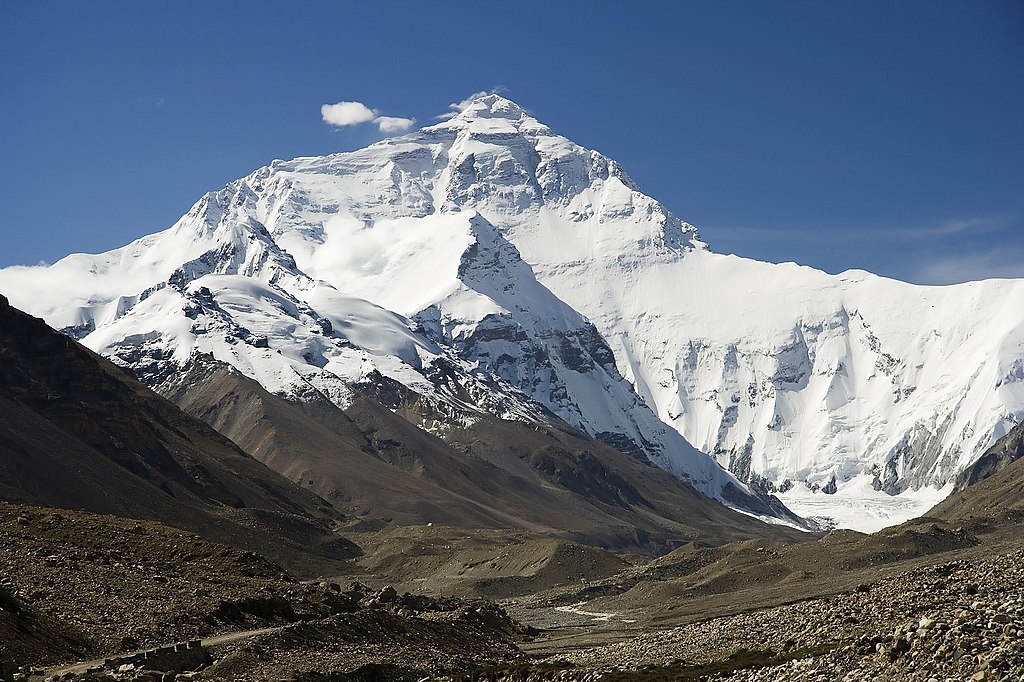“What is ’s highest mountain?” This seemingly harmless question has caused a public controversy in Taiwan, a country where geography and politics are deeply entwined.
On June 11, Chen Qineng (陳啟能), a lawmaker of the Democratic Progressive Party (DPP), asked Eric Chu (朱立倫), the incumbent mayor of New Taipei City and Chairman of the Guomindang, an apparently simple question: “What is ’s highest mountain?”
“Taiwan’s highest mountain is Yushan,” answered Eric Chu. “But according to the Constitution," he added, "the country’s highest mountains are the Himalayas.”
Chen Qineng’s question was not trivial. Its purpose was to make Eric Chu reveal his view on the controversial issue of Taiwan’s sovereignty. Taiwan is officially known as the Republic of China (ROC), a state that in theory still claims to be the legitimate government of China.

Mount Everest (courtesy Luca Galuzzi: commons.wikimedia.org)
Chen Qineng was not satisfied with that answer. He mentioned the fact that on June 9 the Minister of Education had stated that the highest mountains of the Republic of China are the Himalayas. “If even the Minister says this, what are we going to teach our children?” asked Chen.
“Geography and history are controversial subjects,” replied Eric Chu. “Mainland China’s highest mountains are the Himalayas … Mainland China is a neutral term. As far as Taiwan is concerned, the highest mountain is Yushan.”
The Republic of China was founded in mainland China in 1912, after the Qing Dynasty had been overthrown during the so-called Xinhai Revolution. The leader of the revolution was Sun Yat-sen. He had been fighting for years to oust the imperial rulers and establish a Republic. Shortly afterwards Sun founded the Guomindang (Chinese Nationalist Party), which won a majority in China’s first democratically elected parliament.
In 1949, however, the Republic of China was overthrown by Mao Zedong’s Communists, who founded the People's Republic of China (PRC). The Guomindang government retreated to Taiwan, where the ROC continued to regard itself as the legitimate government of all China.
The geography of the ROC poses a series of questions. What is the national territory of the ROC? Is Taiwan part of the ROC? And which parts of China does the ROC claim?
In 1937 the Guomindang promulgated a Provisional Constitution, commonly known as the 5/5 Constitution because it became effective on the 5th day of the 5th month of the 25th year of the Republic (5 May 1937). Article 4 of the Constitution defined the territory of the ROC as follows:
The territory of the Republic of China comprises Jiangsu, Zhejiang, Anwei, Jiangxi, Hubei, Hunan, Sichuan, Xikang, Hebei, Shandong, Shanxi, Henan, Shaanxi, Gansu, Qinghai, Fujian, Guangdong, Guangxi, Yunnan, Guizhou, Liaoning, Jilin, Heilongjiang, Rehe, Chaha’er, Suiyuan, Ningxia, Xinjiang, Mongolia [Menggu] and Tibet. The territory of the Republic of China can be altered only by decision of the National Assembly.中華民國領土為江蘇、浙江、安徽、江西、湖北、湖南、四川、西康、河北、山東、山西、河南、陝西、甘肅、青海、福建、廣東、廣西、雲南、貴州、遼寧、吉林、黑龍江、熱河、察哈爾、綏遠、寧夏、新疆、蒙古、西藏等固有之疆域 。 中華民國領土,非經國民大會議決不得變更.
The Constitution did not mention Taiwan, Hong Kong and Macau, but it included Mongolia, which is now an independent state. In 1937 Taiwan, Hong Kong and Macau were parts of, respectively, the Japanese, the British and the Portuguese colonial empires. Islets such as Diaoyu or Nansha were not mentioned, either.
This has led advocates of Taiwan’s independence to claim that Taiwan has never belonged to the ROC. At a conference entitled “Oppose the 1992 Consensus” (反九二共識), held on March 2015 in the southern Taiwanese city of Tainan, a former associate professor at Zhongxing University, Shen Jiande (沈建德), stated that the 1937 Constitution as well as the Constitution passed in 1946 do not mention Taiwan as part of the ROC.
According to the Constitution itself, every territorial change should have been approved by the National Assembly. But no such constitutional reform was ever enacted. However, later amendments to the ROC Constitution do mention the so-called “free area of the Republic of China”, which implicitly refers to Taiwan, Penghu, Mazu and Jinmen.
The 5/5 Constitution seems to affirm that the country’s borders cannot be altered. In this case, Taiwan would not belong to the ROC. On the other hand, however, it is possible that the ambiguous wording was meant to leave open the possibility for the National Assembly to add new territories.
As William A. Callahan has shown in his book China: The Pessoptimist Nation, national maps and territorial claims have been in flux since the early days of the ROC. Although both the Guomindang and the CCP claim various areas as inalienable parts of China since ancient times, in reality the domain of the state has been reinvented several times.
The current president of the Republic of China, Ma Ying-jeou, has repeatedly stated that mainland China is part of the ROC. However, even if one accepted the concept that some day mainland China and Taiwan may be reunified under the ROC constitution, it is not even clear what ‘mainland China’ means. For instance, should the ROC include Mongolia, Hong Kong and Macau?
The Republic of China Yearbook 2014, published by the government, states that “Taiwan comprises about 99 percent of the territory now under the Republic of China’s (ROC) jurisdiction,” but it does not mention which areas of mainland China are supposed to belong to the ROC. However, the Yearbook includes a section on the islands claimed by the ROC: “[I]slands in the South China Sea claimed by the ROC include the Dongsha (Pratas) Islands 東沙群島, the Nansha (Spratly) Islands 南沙群島, the Xisha (Paracel) Islands 西沙群島 and the Zhongsha Islands (Macclesfield Bank) 中沙群島. Further, lying about 170 kilometers northeast of Taiwan is the Diaoyutai Islands 釣魚臺列嶼, a small island group that includes Diaoyutai Island 釣魚臺, Huangwei Isle 黃尾嶼and Chiwei Isle 赤尾嶼..”
While the ROC Constitution does not have a list of the country’s provinces, it does mention both Mongolia and Tibet. The ROC government has even a Commission of Mongolian and Tibetan Affairs, which was first established in 1929.
Comments
Post a comment